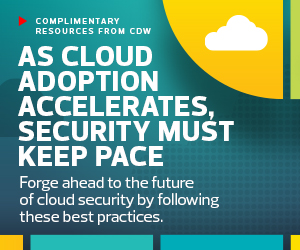During a CDW Tech Talk interview this year, Sarah Kent, a security assessment specialist with CDW, explained that the added complexities of multicloud environments made tools that enable CSPM — including DevOps tools for automated monitoring and policy enforcement technologies to mandate configuration standards — increasingly important for many lines of business.
“CSPs provide similar services, but each one has a different security policy and a different way of implementing those policies,” Kent said. “IT staff don’t have the knowledge yet to secure all cloud provider platforms, and data encryption of backups is no longer centralized. The bottom line is that the complexities of multicloud translate into more complexity with security.”
Recent research on this issue bears out. A report from the Cloud Security Alliance and VMware released in September examined the primary causes of cloud misconfigurations across industries. It found that 62 percent of respondents blamed a lack expertise in cloud security best practices, while 49 percent cited a lack of security visibility and monitoring, and 43 percent pointed to rapid deployment as the main culprit.
Worst of all, some compliance mechanisms can fall out of date (22 percent) or remain at the default settings (34 percent), leaving cloud applications and services alike at risk of serious attacks.
The Benefits of Cloud Computing in Banking
The need for CSPM solutions is growing in response to the demand for cloud computing in the banking industry. While the industry was very early to computing in general, compliance and security concerns have slowed the growth for cloud solutions. This is especially true for critical bank systems, where concerns about managing security, privacy and assets remain top of mind.
But the mindset around the cloud is quickly changing. One recent study conducted by Google Cloud with the Harris Poll found that 83 percent of financial services leaders reported that their companies relied on cloud technologies in some form. But a plurality (38 percent) are using hybrid cloud solutions, with smaller portions using single-cloud (28 percent) and multicloud (17 percent) solutions. That could eventually shift: 88 percent of respondents who aren’t using multicloud solutions are considering such a strategy in the future.
MORE FROM BIZTECH: What financial services need to know about ransomware.
Nikhil Girdhar, the head of product marketing for cloud security solutions at CloudHealth by VMware, says the financial industry’s focus customer service creates a need to keep up by continually building improved services using new technologies.
“Companies in these sectors are rapidly embracing cloud-native technologies and DevOps automation to speed up innovation and better serve customers,” he says. “However, the adoption of these newer technologies is also fraught with a lot of risk, as witnessed in various cloud security breaches stemming from human errors and cloud misconfigurations that have made headlines.”
How Do CSPM Solutions Work?
CSPM helps organizations manage risks by setting a series of recommended standards for configuration. Those configurations can then be applied across an organization’s tools in an automated way, using a DevOps-style approach to cloud security.
“Properly enabled cloud security posture management can automatically and continuously monitor cloud instances against a variety of requirements,” says Jim Reavis, co-founder and CEO of the Cloud Security Alliance.
Girdhar adds that CSPM solutions help enterprise businesses align on consistent standards across the organization, creating opportunities not only to improve guardrails around security and compliance but also to reduce risk along the way.
“This can help developers and security save significant costs and speed up software development,” he says.
How CSPM Aligns with Cloud Compliance Standards
The financial industry has to work within compliance standards such as the Payment Card Industry Data Security Standard and the General Data Protection Regulation, which can be difficult to manage at scale. Technology must be able to scale up with organizations — and that’s what CSPM solutions are designed to do.












